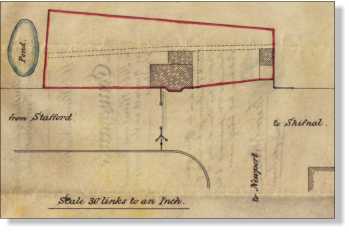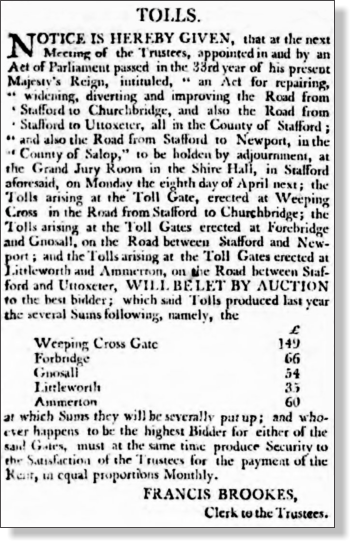The Stafford to Newport turnpike road via Gnosall
“Turnpike roads may be defined as roads over which bodies of trustees were empowered by act of parliament to levy tolls
initially for their improvement and subsequently for their maintenance.”
A D M Phillips and B J Turton, “The turnpike network of Staffordshire, 1700-1840”
1
General
Before 1750 Staffordshire’s turnpike roads ran from Lichfield northwest to Stone and beyond and northeast to Burton upon
Trent (1750), and there was a network of roads around Wolverhampton. There were no turnpike roads to Stafford.
(A petition from Nantwich in 1743 complained that “a good Part of the Roads from the City of Chester to the Borders of
Stafford are very founderous and out of Repair; great Part thereof lying upon a dead Flat, and other Parts being worn into
deep Hollows; so that the Wheel carriages cannot, without great difficulty, get through them.”)
2
The 1760s saw a great deal of road building. Watling Street was partially turnpiked, forming part of the London to
Shrewsbury trunk road. The Wolverhampton-Penkridge-Stone highway was completed, giving Stafford a north-south
turnpiked road (via Gaolgate and Greengate). Stafford also gained a northward turnpike link to Leek. West from Stafford
turnpikes now linked it to Eccleshall to join the Chester turnpike, and to Forton and Newport via Woodseaves.
Gnosall
The road from Stafford to Newport via Haughton and Gnosall remained un-turnpiked until an act of 1793 (33 Geo III, c.153)
when three radial routes from Stafford were turnpiked:
3
•
East through Weston upon Trent to Uttoxeter,
•
South via Huntingdon and Cannock to Church Bridge,
•
Westwards through Haughton and Gnosall and over the county boundary to Newport. Phillips & Turton,
In April 1795 the Clerk to the Trustees, Francis Brookes (a Stafford solicitor) put an announcement in the Staffordshire
Advertiser that the trustees would meet at the Swan Inn in Stafford on Monday 4
th
May to put the above into effect.
4
The work seems to have progressed gradually. In 1801 Mr Brookes announced the trustees would meet on 6
th
April in the
Grand Jury Room of the Shire Hall to let the tolls from the Weeping Cross and Amerton tollgates by auction. Weeping Cross
had made £135 profit the previous year and Amerton £18. In 1802 the tolls from the same two tollgates were auctioned, and
applications were requested for the surveying of the Newport road.
5
No references can be found in 1803 but the Gnosall tollgate was evidently in existence by then as in May 1804 Mr Brookes
advertised that the Trustees would meet in the Grand Jury Room at Stafford Shire Hall, at 11am on 11
th
June to auction the
tolls from the tollgates at Littleworth between Stafford and Uttoxeter, and at Gnosall, for one year to the highest bidder,
6
stating that the previous year the Gnosall tollgate had turned a profit of £54, at which bidding was to start.
It’s assumed that the Gnosall tollgate was at the position shown for “Toll Gate House and Garden” on the 1838 tithe map (2270), at the junction of the A518 with Wharf Road, strategically near the Doley Brook bridge to catch travellers from Gnosall village and Audmore as well as those from Stafford and Haughton. The property was owned at that time by the Road Commissioners of Newport and occupied in 1838 by Richard and Margaret Norris. The plan on the right shows the Toll house, bar and pedestrian gate. (The Gnosall area contained another tollhouse, the “Lawn Head Gate”, Plot No. 305 on the tithe map, at the junction of the Gnosall-Knightley road and the Stafford- Woodseaves turnpike (B5405). This was owned by the Trustees of Turnpike Roads, and occupied in 1837 by James Talbot, a shoemaker. He was convicted in Stafford 1844 of taking a toll on a threshing machine when John Hall the owner was absent. 7 John Simkin of Knightley was listed as a toll collector on the baptism register in 1856.) This notice on the right is from the Staffordshire Advertiser, 9 March 1805 In April 1805 the tolls were auctioned again. A later advertisement the same month includes Newport (£25). Advertisements for timber auctions at the Anchor in the early 19 th century often stressed the proximity the turnpike road: in 1805 timber from New House Farm near Gnosall (Mr Reynolds) was described as “conveniently situated near the centre of the turnpike road from Stafford to Newport”. 8 It must have made transport a great deal easier (though not as easy as on the Stafford and Worcestershire Canal, which was mentioned in advertisements of timber near Stafford.) Advertisements for sales of land also stressed proximity to the turnpike where appropriate. In 1807, at the Aqualate Estate, Sir John Fenton Fletcher obtained a court order permitting the Newport to Stafford turnpike road to be diverted from what are now the Main and Back drives of the park to its current position south of the park. 9 In 1814 a supplementary Act of Parliament was passed to repair the Stafford to Newport turnpike road; it also involved appointing extra trustees and changing the toll rates, which were to be double on Sundays. 10 The auctioning of the tolls went on - in January 1830 Newport Gate and Gnosall Gate were announced to be worth £226 each and an auction was announced. However for some reason, the auction was postponed, or held again, and this time the tolls were being sold in parcels or lots which suggests there was subcontracting going on. Starting prices for bids Gnosall Gate Newport Gate 1831 £210 £210 1832 £239 £239 1835 £236 £236 1836 auctioned in parcels or lots; total figure £1497 1837 £218 £218 1838 £126 £84 1839 £130 £118 1847 £270 £270 The above figures are from the advertisements in the Staffordshire Advertiser. It would be interesting to know why Newport Gate was so cheap in 1838. It didn’t affect the Gnosall turnpike but in 1831 the Newport turnpike trustees met at the Union Hotel in Newport to agree “the removal of the toll-gate now erected across the turnpike road leading from Newport … to Eccleshall … at Knightley in the parish of Gnosall” and of building a new one at Whitley Heath in the parish of Eccleshall. 11 This would be on the present A519 to the north of the Lawn Head tollgate. In 1835 a letter from “A.B.” appeared in the Staffordshire Advertiser demanding more transparency from the turnpike trusts: “the Turnpike Trustees levy a very heavy tax on the public, … they are self-elected and irresponsible, and hardly anything is known as to their mode of transacting business. Corruptions of all kinds have been found to prevail in some Trusts. … The public have an undoubted right to know how the money taken from their pockets is expended.” As another example of the proximity of the turnpike road, and then the canal, and then the railway, used as an incentive, the advertisements for sale of the Travellers Inn at Bank Top are interesting - in 1830 it was stated that the inn “adjoins the turnpike road from Stafford to Newport” and that it was near “the projected Birmingham and Liverpool canal now cutting”; an advertisement in 1832 repeated that it adjoined the turnpike road and was “within a hundred yards of the Birmingham and Liverpool Junction Canal”. A later advertisement in 1847 still stressed the turnpike road but added it was near “the intended stations on the Shrewsbury and Stafford and Norton Bridge Railways”. (Gnosall station opened in 1 st June 1849.) The coming of the railways hit the profitability of the turnpike road system. “Many turnpike trusts were wound up under General Acts of Parliament between 1873 and 1878. The transfer of resources and sale of assets to repay loans were supervised by the Local Government Board which acted as arbiter in the case of disputes. Toll-houses were sold, gates torn down and responsibility for the main roads passed to Highway Boards. … Under the Highways Act of 1878 all dis-turnpiked roads became "Main Roads" as did some ordinary highways. By the Local Government Act of 1888 the entire maintenance of main roads was thrown upon the County Councils.” 12 Gnosall’s tollgate house was sold to Henry Newton (cement manufacturer, Mill Lane) 25th October 1880 for £110. He sold it to Mary Butler on 15 February 1889 from the Royal Oak for £145. She built Oak Cottage on the site. The property remained in the family until at least 1959. Felicity Potter 1 Collections for a History of Staffordshire, 4 th series, vol. 13. 2 http://www.turnpikes.org.uk/KL%20Nantwich%20Turnpikes.pdf 3 Phillips & Turton, “The turnpike network of Staffordshire 1700-1840”4
Staffordshire Advertiser, 24 April 1795
5 Staffordshire Advertiser, 20 Feb. 1802 6 Staffordshire Advertiser, 19 May 1804 7 http://www.archives.staffordshire.gov.uk 8 Staffordshire Advertiser, 16 Feb. 1805 9 http://www.discovershropshire.org.uk/html/search/verb/GetRecord/resource:20070421155926 10 54 Geo. III.c.153 11 Staffordshire Advertiser, 10 Sept. 1831 12 http://www.turnpikes.org.uk/The%20Turnpike%20Roads.htm

Click above for home screen



















